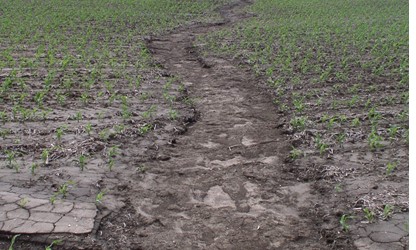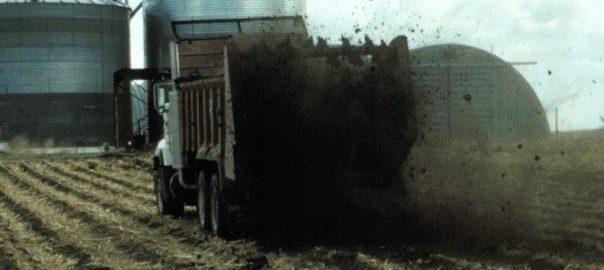Manure’s Value to Erosion and Runoff
Manure’s impact on formation of larger and more stable soil aggregates was the focus of a July 2017 MaSH blog. This article reviews the soil erosion and runoff benefits that results from changes to soil’s physical characteristics from manure.

Figure 1. Can manure be part of the solution for the erosion in this photo?
Charles Wortmann and Dan Walters, faculty with the University of Nebraska-Lincoln, provide several important insights in a field research initiative that monitored soil erosion, runoff, and phosphorus (P) loss from replicated field plots over three cropping seasons immediately after manure application and four subsequent years when no manure was applied. This blog reviews results published in a Journal of Environmental Quality article, Phosphorus Runoff During Four Years Following Composted Manure Applications, and related information.
Take Home Message:
This research demonstrates that manure has significant value for reducing runoff and erosion. It does not solve the problems illustrated in the photo. In combination with other soil management practices, manure can protect our soils and limit agriculture’s environmental costs. However manure can be an environmental negative if phosphorus is allowed to accumulate in soils. To achieve the environmental benefits of manure and minimize the risks, manure application rates and frequency of re-application to the same field must maintain soil P levels near the agronomic levels required by the selected crops.
Wortmann and Walters’s primary intent was to understand P losses from manure application. However, several important results on soil physical and chemical characteristics were observed. A low and high P composted beef manure was applied to replicated runoff plots (measuring 12 by 36 feet) with a median slope of 5.5% and soil series of Pohocco silt loam. Manure was applied to meet crop nitrogen requirements for 3 years in a row. Runoff plots were evaluated for these three cropping seasons immediately following manure application as well as three additional cropping seasons with no manure application. All erosion, runoff, and P loss resulting from natural rainfall and pivot irrigation was quantified for the period of March through August of each of the six cropping seasons.

Figure 2: Application of beef manure produced runoff and erosion benefits during the cropping seasons immediately following manure application (green bars) and for 3 additional crop years (blue bars) after the last manure application. Reference: Heartland publication RP187, Agricultural Phosphorus Management and Water Quality in the Midwest.
Lesson 1: Compost application reduced erosion…
and runoff by approximately 2/3 during the three cropping seasons following manure application (Green bars in Figure 2). Improvements in soil water holding capacity and soil infiltration rates (see July 2017 MaSH blog) were responsible for the lower runoff and erosion levels. One would expect less total sediment, nitrogen, and pesticide levels reaching nearby surface water based upon these results. However, increased P levels in neighboring surface waters is an expected negative environmental impact (more in Lesson 4 below).
Lesson 2: Manure application has a residual benefit…
for runoff and erosion that persisted for at least the next 3 cropping seasons (Blue bars in Figure 2). This research observed an approximate reduction in runoff of 40% and erosion of 55%. The reduced runoff also suggest additional soil moisture storage and greater crop resiliency to dry periods.
Lesson 3: Additional soil quality benefits…
were observed for soil bulk density, soil organic matter, and pH (Table 1). Although visual evidence of compost disappeared within one year, soil organic matter content and pH benefits of manure were observed 4 years after the last manure application.
Lesson 4: Increased soil P levels…
were significant as a result of three consecutive years of compost manure application and producing increased P movement in runoff and erosion. Application to meet crop N requirements applies more P than is required for crop production. Repeating this practice three years in a row as well as application of a high P compost (manure from cattle fed diet with distillers grains) further aggravates this negative environmental impact. If manure is to be applied at a nitrogen based rate, it is desirable both economically and environmentally to not reapply manure to the same field until soil P levels return to a level requiring additional P supplementation. For some manures with a low N to P ratio, it may be desirable to apply manure at a rate equal to the P removed by the next three to five cropping seasons and then supplement with commercial nitrogen fertilizer to meet crop N requirements. This strategy will produce economic and environmental value, while minimizing the P impact on local surface water.
| Treatment | Bulk Density (lbs/ft3) | Soil Organic Matter (%) | Soil pH |
| 0 to 2 inch soil sample: | |||
| Compost | 65 to 66 | 5.2 to 5.8 | 7.4 |
| No Compost | 70 | 3.9 | 5.8 |
| 2 to 4 inch soil sample: | |||
| Compost | 76 | 3.5 | 6.9 to 7.0 |
| No Compost | 77 | 3 | 5.5 |
Manure’s economic and soil improvement benefits should both be recognized and built into successful cropping systems. Thanks to the work of Wortmann and Walters, we have better insights as to how manure can improve the physical characteristics of soils thus reducing runoff and erosion.
Author: Rick Koelsch, University of Nebraska – Lincoln
Reviewers: Charles Shapiro, University of Nebraska-Lincoln; Gary Lesoing, University of Nebraska-Lincoln; John Gilley, USDA Agricultural Research Service

That is really cool that soil management practices can help protect our soils with manure. Maybe I should look into getting soil erosion control sometime soon. Then we would be able to protect our soil and save in environmental costs.
It’s really interesting how you said that compost can help to reduce erosion by 2/3. This would be really great because it would allow your soil to keep the quality topsoil without worrying about it eroding away. That way you won’t have to worry about not being able to grow back the crops that you want to.